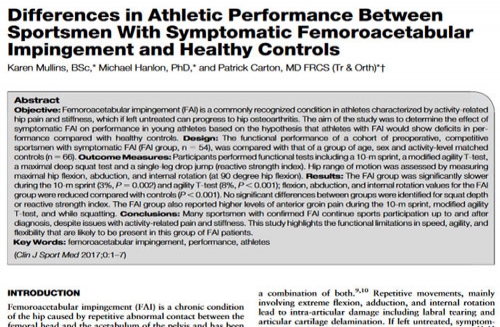Differences in Athletic Performance Between Sportsmen With Symptomatic Femoroacetabular Impingement and Healthy Controls
Karen Mullins, BSc,* Michael Hanlon, PhD,* and Patrick Carton, MD FRCS (Tr & Orth)*†
Objective
Femoroacetabular impingement (FAI) is a commonly recognized condition in athletes characterized by activity-related hip pain and stiffness, which if left untreated can progress to hip osteoarthritis. The aim of the study was to determine the effect of symptomatic FAI on performance in young athletes based on the hypothesis that athletes with FAI would show deficits in performance compared with healthy controls.
Design
The functional performance of a cohort of preoperative, competitive sportsmen with symptomatic FAI (FAI group, n=54), was compared with that of a group of age, sex and activity-level matched controls (n=66).
Outcome Measures
Participants performed functional tests including a 10-m sprint, a modified agility T-test, a maximal deep squat test and a single-leg drop jump (reactive strength index). Hip range of motion was assessed by measuring maximal hip flexion, abduction, and internal rotation (at 90 degree hip flexion).
Results
The FAI group was significantly slower during the 10-m sprint (3%, p=0.002) and agility T-test (8%, p<0.001); flexion, abduction, and internal rotation values for the FAI group were reduced compared with controls (p<0.001). No significant differences between groups were identified for squat depth or reactive strength index. The FAI group also reported higher levels of anterior groin pain during the 10-m sprint, modified agility T-test, and while squatting.
Conclusions
Many sportsmen with confirmed FAI continue sports participation up to and after diagnosis, despite issues with activity-related pain and stiffness. This study highlights the functional limitations in speed, agility, and flexibility that are likely to be present in this group of FAI patients.
Key Words: femoroacetabular impingement, performance, athletes
(Clin J Sport Med 2017;0:1–7)







